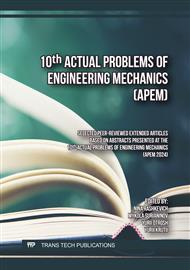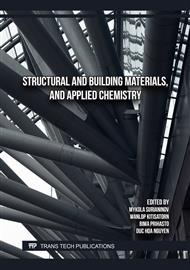[1]
A. Chernukha, A. Teslenko, P. Kovaliov, O. Bezuglov, Mathematical modeling of fire-proof efficiency of coatings based on silicate composition, Materials Science Forum, 1006 (2020) 70–75.
DOI: 10.4028/www.scientific.net/msf.1006.70
Google Scholar
[2]
Andrii Kovalov, Yurii Otrosh, Oleksandr Chernenko, Maxim Zhuravskij, Marcin Anszczak. Modeling of Non-Stationary Heating of Steel Plates with Fire-Protective Coatings in Ansys under the Conditions of Hydrocarbon Fire Temperature Mode, In Materials Science Forum, 1038 (2021) pp.514-523.
DOI: 10.4028/www.scientific.net/msf.1038.514
Google Scholar
[3]
Y. Danchenko, V. Andronov, E. Barabash, T. Obigenko, E. Rybka, R. Meleshchenko, A. Romin, Research of the intramolecular interactions and structure in epoxyamine composites with dispersed oxides, Eastern-European Journal of Enterprise Technologies, 6 (12–90) (2017) 4–12.
DOI: 10.15587/1729-4061.2017.118565
Google Scholar
[4]
A. Pilipenko, H. Pancheva, A. Reznichenko, O. Myrgorod, N. Miroshnichenko, A. Sincheskul, The study of inhibiting structural material corrosion in water recycling systems by sodium hydroxide, Eastern-European Journal of Enterprise Technologies, 2 (1–85) (2017) 21–28.
DOI: 10.15587/1729-4061.2017.95989
Google Scholar
[5]
Kovalov, A., Otrosh, Y., Kovalevska, T., & Safronov, S. Methodology for assessment of the fire-resistant quality of reinforced-concrete floors protected by fire-retardant coatings, In Materials Science and Engineering. IOP Publishing, 708 (1) (2019) p.012058.
DOI: 10.1088/1757-899x/708/1/012058
Google Scholar
[6]
Yu. Otrosh, M. Surianinov, O. Holodnov, O. Starova, Experimental and computer researches of ferroconcrete beams at high-temperature influences, Materials Science Forum, 968 (2019) 355–360.
DOI: 10.4028/www.scientific.net/msf.968.355
Google Scholar
[7]
Kovalov, A., Purdenko, R., Otrosh, Y., Tоmеnkо V., Rashkevich, N., Shcholokov, E., Pidhornyy, M., Zolotova, N., & Suprun, O. Assessment of fire resistance of fireproof reinforced concrete structures. Eastern-European Journal of Enterprise Technologies, 5 (1 (119)) (2022) 53–61.
DOI: 10.15587/1729-4061.2022.266219
Google Scholar
[8]
Bashynska, O., Otrosh, Y., Holodnov, O., Tomashevskyi, A., & Venzhego, G. Methodology for Calculating the Technical State of a Reinforced-Concrete Fragment in a Building Influenced by High Temperature. Materials Science Forum, 1006 (2020)166–172.
DOI: 10.4028/www.scientific.net/msf.1006.166
Google Scholar
[9]
G. Shabanova, O. Myrgorod, O. Pyrohov, O. Murashko, Barium aluminates and the study of their basic thermodynamic data, 2840(1) (2023) 020007.
DOI: 10.1063/5.0167753
Google Scholar
[10]
O. Mirgorod, G. Shabanova, A. Ruban, V. Shvedun, Experiment Planning for Prospective Use of Barium-Containing Alumina Cement for Refractory Concrete Making, In Materials Science Forum. Trans Tech Publications Ltd, 1038 (2021) 330-335.
DOI: 10.4028/www.scientific.net/msf.1038.330
Google Scholar
[11]
J. Borim, Modelagem e controle de um processo de endurecimento de pelotas de minério de ferro [dissertation], Belo Horizonte: Universidade Federal de Minas Gerais, (2000).
DOI: 10.33425/2693-1516.1017
Google Scholar
[12]
L.Y. Dworkin, Building binders, Rivne, 2019.
Google Scholar
[13]
Z. Klimenko, N. Petrovska, B. Fedun, Special cements for pelletising metallurgical raw materials, Bulletin of Lviv Polytechnic Institute, 111 (1977) P. 48-50.
Google Scholar
[14]
V. Taranenkova, Ye. Ivchenko, M. Lisyutkina, S. Linnik, Investigation of the regularity of manifestation of binding properties by ferrites of alkaline-earth elements using the concept of electronegativity S.S. Batsanova, Modern technologies of refractory non-metallic and silicate materials: II International Conf. of Students, Postgraduates and Young Scientists, Kharkiv : NTU «KhPI» (2011) P. 45-46.
Google Scholar
[15]
G. Sloccari, E. Luсchini, Subsolidus phase relationships in the system BaO-CaO-Fe2O3, Ceramurgia Int., V.3, № 1 (1977) P. 10-12.
DOI: 10.1016/0390-5519(77)90100-4
Google Scholar
[16]
O. Borisenko, S. Logvinkov, G. Shabanova, O. Myrgorod, Thermodynamics of Solid-Phase Exchange Reactions Limiting the Subsolidus Structure of the System MgO-Al2O3-FeO-TiO2, Materials Science Forum, 1038 (2021) 177-184.
DOI: 10.4028/www.scientific.net/msf.1038.177
Google Scholar
[17]
V. Deyneka, G. Shabanova, V. Taranenkova, Estimation of liquidus surfaces of binary and ternary sections of the system CaO – BaO – Fe2O3. Vestnik of NTU «KhPI», Kharkiv, 25 (2005), P. 105-108.
Google Scholar
[18]
V. Tokarchuk, L. Nudchenko, Yu. Kovalenko, Technology of special binding materials and products based on them, teaching. manual for students specialty Chemical technologies and engineering, Kyiv, KPI named after Igor Sikorskyi, 2022.
Google Scholar
[19]
L.Y. Dworkin, Properties of mineral building materials: teaching. Manual, Rivne: NUVHP, 2019.
Google Scholar
[20]
L.Y. Dworkin, S.D. Lapovska, Construction materials science: Textbook, Rivne: NUVHP, 2016.
Google Scholar
[21]
V. Kazimirov, E. Rusanov, Radiography of crystalline materials: ed. manual, K., Kyiv University of the Orthodox Church, 2016.
Google Scholar
[22]
E. Solovyova, E. Pashkova, Y. Gomza, Influence of synthesis conditions on the fractal structure and properties of nanodispersed barium hexaferrite, Ukrainian Chemical Journal, T. 76, No. 3, (2010) P. 30-35.
Google Scholar
[23]
S.I. Pinpchuk, Solid State Chemistry (short course): textbook, Kyiv, Artek Publishing House, 2018.
Google Scholar
[24]
M. Bulzan, E. Segal, The influence of Fe2O3 on the thermal stability of BaCO3. Rev. Roum. Chim. V. 21, № 5(1976) P. 651-653.
Google Scholar
[25]
V. Vlkov, А. Deneva, D. Stavrakeva, Phase studies of barium ferrites in the high-base part of the system BaO – Fe2O3, Stavrakeva Building materials and silicate industry, 20, № 2 (1979) P. 3-5.
Google Scholar



